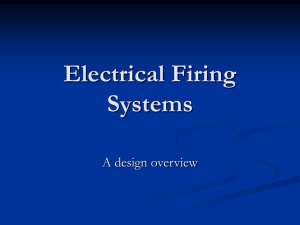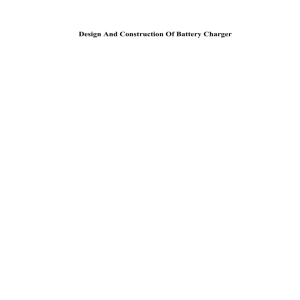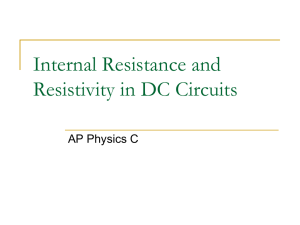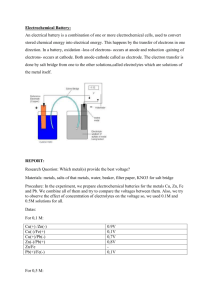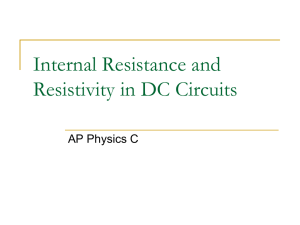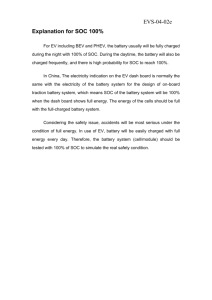Exercises – Chapter 10
advertisement
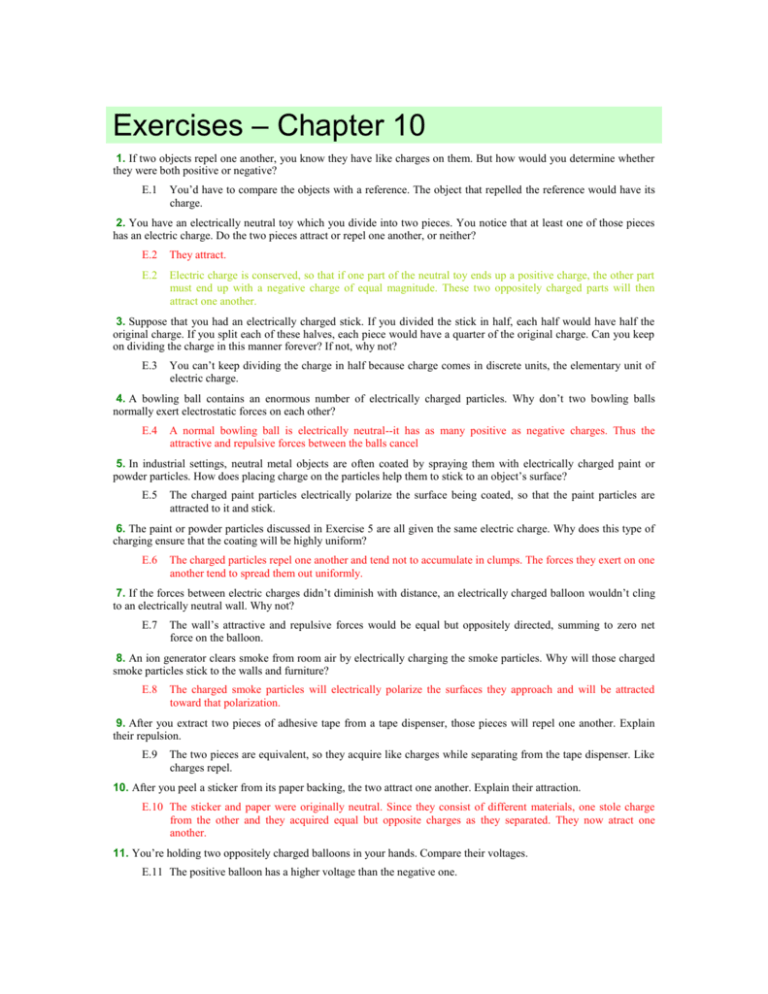
Exercises – Chapter 10 1. If two objects repel one another, you know they have like charges on them. But how would you determine whether they were both positive or negative? E.1 You’d have to compare the objects with a reference. The object that repelled the reference would have its charge. 2. You have an electrically neutral toy which you divide into two pieces. You notice that at least one of those pieces has an electric charge. Do the two pieces attract or repel one another, or neither? E.2 They attract. E.2 Electric charge is conserved, so that if one part of the neutral toy ends up a positive charge, the other part must end up with a negative charge of equal magnitude. These two oppositely charged parts will then attract one another. 3. Suppose that you had an electrically charged stick. If you divided the stick in half, each half would have half the original charge. If you split each of these halves, each piece would have a quarter of the original charge. Can you keep on dividing the charge in this manner forever? If not, why not? E.3 You can’t keep dividing the charge in half because charge comes in discrete units, the elementary unit of electric charge. 4. A bowling ball contains an enormous number of electrically charged particles. Why don’t two bowling balls normally exert electrostatic forces on each other? E.4 A normal bowling ball is electrically neutral--it has as many positive as negative charges. Thus the attractive and repulsive forces between the balls cancel 5. In industrial settings, neutral metal objects are often coated by spraying them with electrically charged paint or powder particles. How does placing charge on the particles help them to stick to an object’s surface? E.5 The charged paint particles electrically polarize the surface being coated, so that the paint particles are attracted to it and stick. 6. The paint or powder particles discussed in Exercise 5 are all given the same electric charge. Why does this type of charging ensure that the coating will be highly uniform? E.6 The charged particles repel one another and tend not to accumulate in clumps. The forces they exert on one another tend to spread them out uniformly. 7. If the forces between electric charges didn’t diminish with distance, an electrically charged balloon wouldn’t cling to an electrically neutral wall. Why not? E.7 The wall’s attractive and repulsive forces would be equal but oppositely directed, summing to zero net force on the balloon. 8. An ion generator clears smoke from room air by electrically charging the smoke particles. Why will those charged smoke particles stick to the walls and furniture? E.8 The charged smoke particles will electrically polarize the surfaces they approach and will be attracted toward that polarization. 9. After you extract two pieces of adhesive tape from a tape dispenser, those pieces will repel one another. Explain their repulsion. E.9 The two pieces are equivalent, so they acquire like charges while separating from the tape dispenser. Like charges repel. 10. After you peel a sticker from its paper backing, the two attract one another. Explain their attraction. E.10 The sticker and paper were originally neutral. Since they consist of different materials, one stole charge from the other and they acquired equal but opposite charges as they separated. They now atract one another. 11. You’re holding two oppositely charged balloons in your hands. Compare their voltages. E.11 The positive balloon has a higher voltage than the negative one. 12. You begin to separate the two balloons in Exercise 11. You do work on the balloons, so your energy decreases. Where does your energy go? E.12 The energy becomes electrostatic potential energy in the balloons 13. When you separate the balloons in Exercise 12, do their voltages change? If so, how do those voltages change? E.13 Their voltages change. The positive balloon’s voltage increases; the negative balloon’s voltage decreases. 14. A car battery is labeled as providing 12 V. Compare the electrostatic potential energy of positive charge on the battery’s negative terminal with that on its positive terminal. E.14 A coulomb of positive charge on the battery's positive terminal has 12 joules more electrostatic potential energy than a coulomb of positive charge on the negative terminal. 15. When technicians work with static-sensitive electronics, they try to make as much of their environment electrically conducting as possible. Why does this conductivity diminish the threat of static electricity? E.15 Conductive materials allow charge to flow and minimize its energy. Everything will tend toward electrical neutrality. 16. Antistatic fabric treatments render the fabrics slightly conducting. How does this treatment help diminish static electricity? E.16 The treated fabric’s mobile charges move about until they have minimized their electrostatic potential energy. The clothes will thereby eliminate as much of their static charges as they can. 17. Holding your hand on a static generator (e.g., a van de Graff generator) can make your hair stand up, but only if you are standing on a good electrical insulator. Why is that insulator important? E.17 For you to accumulate a great deal of charge, you must not be able to lose it easily through conducting paths to the ground. 18. In Exercise 17, having used a hair conditioner recently actually helps your hair stand up. Why? E.18 By allowing charges to move through your hair, the conditioner makes it easier for your hair to accumulate like charges and consequently stand up. 19. The electric field around an electrically charged hairbrush diminishes with distance from that hairbrush. Use Coulomb’s law to explain this decrease in the magnitude of the field. E.19 The forces between a positive charge and the hairbrush decrease with their separation. Thus the electric field that acts on that positive charge also decreases with distance from the hairbrush. 20. Which way does the electric field point around the positive terminal of an alkaline battery? E.20 The electric field points away from the positive terminal’s surface. 21. Which has the stronger electric field between its two terminals: a 1.5-V AA battery or a standard 9-V battery? Explain. E.21 The 9-V battery has the larger voltage gradient and therefore the stronger electric field because its two terminals have a greater voltage difference and a shorter distance between them. 22. You have 100 AA batteries. How should you arrange those batteries to make the strongest electric field? E.22 You should arrange them in a chain, positive terminal touching negative terminal, so that they form an almost complete circle. If you leave a small gap between the positive terminal of one battery and the negative terminal of the battery on the opposite end of the chain, there will then be an extremely strong electric field between those two oppositely charged terminals. 23. It may seem dangerous to be in a car during a thunderstorm, but it’s actually relatively safe. Since the car is essentially a metal box, the inside of the car is electrically neutral. Why does any charge on the car move to its outside surface? E.23 The like charges repel and flow through the conducting car to its outside surfaces. 24. Delicate electromagnetic experiments are sometime performed inside metal walled or screen rooms. Why does that enclosure minimize stray electric fields? E.24 Since charge can move freely through the conducting enclosure, it flows until the entire enclosure has the same voltage. The electric fields within the enclosure are thus greatly reduced. 25. When a positively charged cloud passes overhead during a thunderstorm, which way does the electric field point? E.25 Downward, away from the cloud. 26. The cloud in Exercise 25 attracts a large negative charge to the top of a tree in an open meadow. Why is the magnitude of the electric field larger on top of this tree than elsewhere in the meadow? E.26 Since the tree is effectively a sharp point on the otherwise flat meadow, it has reduced influence on the voltages above it and those voltages change more rapidly with position than the voltages near the broad meadow. The large voltage gradient near the tree is a strong electric field. 27. Corona discharges can occur wherever there is a very strong electric field. Why is there a strong electric field around a sharp point on an electrically charged metal object? E.27 The voltage falls or rises rapidly toward zero in the vicinity of the sharp point and that large voltage gradient is a strong electric field. 28. To minimize corona discharges, electric power pylons sometimes shroud connectors and other sharp features with smoothly curving metal rings or shells. How do those broad, smooth structures prevent corona discharges? E.28 By eliminating sharp features, these structures reduce the voltage gradients around the power pylons. With weaker voltage gradients, corona discharges don’t occur.. 29. If you’re ever standing on a mountaintop when a dark cloud passes overhead and your hair stands up, get off the mountain fast. How would your hair have acquired the charge to make it stand up? E.29 The charged cloud overhead would have induced a large opposite charge to flow up from the ground onto your hair. 30. The power source for an electric fence pumps charge from the earth to the fence wire, which is insulated from the earth. The earth can conduct electricity. When an animal walks into the wire, it receives a shock. Identify the circuit through which the current flows. E.30 Current flows from the power source, through the fence wire, through the animal, through the earth, and back to the power source. 31. A bird can perch on a high-voltage power line without getting a shock. Why doesn’t current flow through the bird? E.31 While charge can accumulate on the bird, it can’t flow as a current because it has nowhere else to go. 32. The two prongs of a power cord are meant to carry current to and from a lamp. If you were to plug only one of the prongs into an outlet, the lamp wouldn’t light at all. Why wouldn’t it at least glow at half its normal brightness? E.32 Without a circuit, charge can’t flow continuously through the lamp. No current flows through the lamp and it remains dark. 33. The rear defroster of your car is a pattern of thin metal strips across the window. When you turn the defroster on, current flows through those metal strips. Why are there wires attached to both ends of the metal strips? E.33 Current arrives through one wire and leaves through the other. 34. If you touch only the tip of a headphone plug to the headphone jack of a portable audio player, what volume will the headphones produce? E.34 Zero volume. E.34 Without a circuit, charge can’t flow continuously through the headphones and no sound is produced. 35. If you transfer some (positive) charge to a battery’s negative terminal, some of that charge will quickly move to the battery’s positive terminal. Will the battery’s store of chemical potential energy have changed and, if so, will it have increased or decreased? E.35 Yes, the battery will have lost some chemical potential energy. 36. If you transfer some positive charge to a battery’s positive terminal, some of that charge will quickly move to the battery’s negative terminal. Will the battery’s store of chemical potential energy have changed and, if so, will it have increased or decreased? E.36 The battery’s store of chemical potential energy will increase. E.36 The positive charge will flow backward through the battery and drive its electrochemical processes backward. The battery will recharge. 37. When you plug a portable appliance into the power socket inside an automobile, current flows to the appliance through the central pin of that socket and returns to the car through the socket’s outer ring. Which of the socket’s contacts has the higher voltage? E.37 The socket’s central pin has the higher voltage. 38. When current is flowing through a car’s rear defroster (Exercise 33), the voltage at each end of the metal strips is different. Which end of each strip has the higher voltage, the one through which current enters the strip or the one through which current leaves, and what causes the voltage drop? E.38 The end through which the current enters the strip has the higher voltage. As the strip extracts energy from this current (turning it into thermal energy), the current loses voltage E.38 Current flows through an ohmic device, such as the defroster, from its higher voltage end to its lower voltage end. The voltage gradient in the device is the electric field that pushes the current through the device. 39. You’re given a sealed box with two terminals on it. You use some wires and batteries to send an electric current into the box’s left terminal and find that this current emerges from the right terminal. If the voltage of the right terminal is 6 V higher than that of the left terminal, is the box consuming power or providing it? Is it more likely to contain batteries or lightbulbs? How can you tell? E.39 Batteries, because something is supplying power to the current. 40. One time-honored but slightly unpleasant way in which a hobbyist determines how much energy is left in a 9-V battery is to touch both of its terminals to his tongue briefly. He experiences a pinching feeling that’s mild when the battery is almost dead but one that’s startlingly sharp when the battery is fresh. (Don’t try this technique yourself.) What is the circuit involved in this taste test? How is energy being transferred? E.40 Current flows from the battery’s positive terminal, through the hobbyist’s tongue, to the battery’s negative terminal. Energy is being transferred from the battery to the hobbyist’s tongue by the current. 41. Spot welding is used to fuse two sheets of metal together at one small spot. Two copper electrodes pinch the sheets together at a point and then run a huge electric current through that point. The two sheets melt and flow together to form a spot weld. Why does this technique work only with relatively poor conductors of electricity such as stainless steel and not with excellent conductors such as copper? E.41 The power deposited in a metal is proportional to its electric resistance, so high-resistance metals heat more. 42. Why is it important that the filament of a lightbulb have a much larger electrical resistance than the supporting wires that carry current to and from that filament? E.42 The filament’s larger resistance ensures that it experiences the main voltage drop and receives most of the current’s electrical power.

